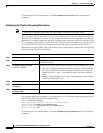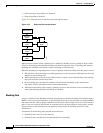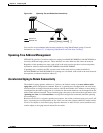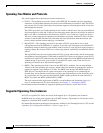
16-3
Catalyst 2960 and 2960-S Switch Software Configuration Guide
OL-8603-09
Chapter 16 Configuring STP
Understanding Spanning-Tree Features
Spanning-Tree Topology and BPDUs
The stable, active spanning-tree topology of a switched network is controlled by these elements:
• The unique bridge ID (switch priority and MAC address) associated with each VLAN on each
switch. In a switch stack, all switches use the same bridge ID for a given spanning-tree instance.
• The spanning-tree path cost to the root switch.
• The port identifier (port priority and MAC address) associated with each Layer 2 interface.
When the switches in a network are powered up, each functions as the root switch. Each switch sends a
configuration BPDU through all of its ports. The BPDUs communicate and compute the spanning-tree
topology. Each configuration BPDU contains this information:
• The unique bridge ID of the switch that the sending switch identifies as the root switch
• The spanning-tree path cost to the root
• The bridge ID of the sending switch
• Message age
• The identifier of the sending interface
• Values for the hello, forward delay, and max-age protocol timers
When a switch receives a configuration BPDU that contains superior information (lower bridge ID,
lower path cost, and so forth), it stores the information for that port. If this BPDU is received on the root
port of the switch, the switch also forwards it with an updated message to all attached LANs for which
it is the designated switch.
If a switch receives a configuration BPDU that contains inferior information to that currently stored for
that port, it discards the BPDU. If the switch is a designated switch for the LAN from which the inferior
BPDU was received, it sends that LAN a BPDU containing the up-to-date information stored for that
port. In this way, inferior information is discarded, and superior information is propagated on the
network.
A BPDU exchange results in these actions:
• One switch in the network is elected as the root switch (the logical center of the spanning-tree
topology in a switched network). In a switch stack, one stack member is elected as the stack root
switch. The stack root switch contains the outgoing root port (Switch 1), as shown in Figure 16-1
on page 16-4.
For each VLAN, the switch with the highest switch priority (the lowest numerical priority value) is
elected as the root switch. If all switches are configured with the default priority (32768), the switch
with the lowest MAC address in the VLAN becomes the root switch. The switch priority value
occupies the most significant bits of the bridge ID, as shown in Table 16-1 on page 16-5.
• A root port is selected for each switch (except the root switch). This port provides the best path
(lowest cost) when the switch forwards packets to the root switch.
When selecting the root port on a switch stack, spanning tree follows this sequence:
–
Selects the lowest root bridge ID
–
Selects the lowest path cost to the root switch
–
Selects the lowest designated bridge ID
–
Selects the lowest designated path cost
–
Selects the lowest port ID


















